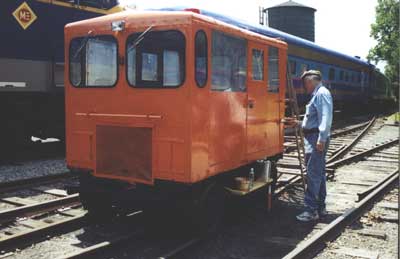

During the period of early railway expansion in North America (1840’s – 1860’s), the only track inspection and light transport vehicle available was the Velocipede and the Pump Car. These early vehicles were powered by a hand-cranking, pumping motion that transmitted power to the wheels.
The Fairmont Gas Engine & Railway Motor Car Co. was founded in Fairmont, Minnesota in 1909 and began building a variety of gasoline-powered motor cars which would replace the Pump Car. These early internal-combustion vehicles became the basis for all motor cars built since. By 1949, the renamed Fairmont Railway Motors Company was offering 19 models of motor cars to customers, most being available in 11 different gauges from 23″ to 66″.
Fairmont became a pioneer in the development of mechanized track maintenance equipment and introduced hydraulic power to the difficult tasks of pulling and driving track spikes and replacing crossties. In the 1940’s Fairmont developed road / rail guide wheel attachments, and its HY-RAIL (R) guide wheel units revolutionized track inspection transportation. Demand was very strong for 50 years, but by the 1970’s, sales of motor cars were slipping, due to the rapidly shrinking railroad network and a widespread switch to Hy-Rail Vehicles. The Hy-Railers, which utilize a commercial truck frame and body that can travel on both track and roadways, began to rapidly replace the faithful motor car as a way to transport trackworkers and equipment. In 1979 Fairmont was acquired by the Harsco Corporation, and became part of Harsco Track Technologies. The last of a total of nearly 73,000 Fairmont motor cars was manufactured in 1991.

The Museum’s Section Gang Car is a Fairmont Railway Motors “A6-F” Model built new for the Morristown & Erie Railroad (M&E) circa 1956. The unit weighs approximately 5,100 lbs, is just under 10 feet long and has a seating capacity of 6-9 workers. It is powered by a Ford Industrial 6-cylinder, 185-horsepower, 300 cubic-inch engine, and is capable of 20- 40 mph. It is a 4-wheel drive model with a 4-speed transmission. Fairmont manufactured 1,216 models of this type between 1956 and 1985. As built, the car features front and rear windscreens and bulkheads as well as a roof. Originally the sides were open, but had additional canvas side-curtains to protect the crew during inclement weather. During the 1980’s the M&E added removable side doors with windows as a feature to further protect the crews and keep the car locked up at night.


The Morristown & Erie’s Maintenance-Of-Way (MOW) workers depended on a series of motor cars throughout the first half of the last century to assist them in making repairs to the track, roadbed, and maintenance of facilities. Around 1956 the M&E received it’s brand new, Fairmont A6-F Heavy Duty Section Gang Car , which was destined to serve its owners for nearly 47 years.



Over the decades the Gang Car could be seen traveling up and down the 11 miles of track owned by the M&E, towing its trailer loaded with replacement crossties, spikes and other work equipment. During those years the Gang Car was present at the scene of many work projects and wore a varity of paint scemes.



By the early 2000’s, the Morristown & Erie Railway had expanded its fleet of Hy-Rail Vehicles to such an extent that its little Fairmont was no longer needed. The decision was made to retire the car and in April 2004, the Morristown & Erie Railway ran the Gang Car (renumbered TC-1, for “Track Car 1”, in the 1980’s) under its own power to Whippany where it was placed on display at the Whippany Railway Museum where visitors can view yet another piece of New Jersey Railroad History that is directly related to the area it served for so long.


